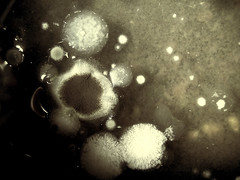
Many houses across the country including Toronto are finding that with the onset on Autumn and more moisture in the air, those horrible mold stains are returning. Mold and spotless houses are normal, don't think that mold says you have a grimy home. Items break or crack in a home and they are not always noticed immediately. That’s usually when mildew crawls into your beautiful home, unseen, until you either discover the well-known displeasing smell or you spot the atrocious growing stains. For some homes, mold is an ongoing problem in rooms like kitchens or bathrooms due to the increased moisture and humidity in these areas. Whether the mold is seasonal or year round the answer to the problem is totally the same.
Do you employ experts or undertake the DIY method?
Of course there are masses of companies out there that would gladly solve this problem for you, but since many people think twice before paying out money on work they can do themselves, here’s some DIY, eco-friendly solutions. Having said that, should you discover that the area affected by mold is rather big (ie over 10 sq ft or so), calling a professional would be a good idea.
Be aware of safety before you try to solve the problem
Even though most species of mold are harmless to humans, there are certain types (like black mold) that are rather toxic. So before you embark on any sanitation, arm yourself with a pair of hefty rubber gloves and an N95 respirator. If you want to be extra careful, you could acquire a test kit from a hardware shop and send a sample of the mold to a lab. If a member of your household has an allergy or respiratory problems then this kit would help you decide which option you pick.
Eco-Friendly Detergents
For cost effectiveness, environmentally friendly and availability, white vinegar comes the best for dealing with mold. Just like it will drive away ants (as we recently reported in the first issue of Toronto homeowner’s guide), it will not only obliterate the fungi, but also bacteria; it will even dissolve lime scale. While there is always expensive anti-fungal solutions on your supermarket shelf, distilled white vinegar is totally bio-degradable.
Extermination and Prevention
Mold and its removal requires more than a single treatment. The space the mold has developed must be carefully cleaned. Then it is imperative to make the rooms in your home less mold-friendly. When cleaning hard surfaces such as tile or ceramic, linoleum, tile grout, or plastic such as shower curtains, wet the effected area so that the spores don’t become airborne, then simply give it a good scour with a cleaner of your choice. Once you have finished cleaning, totally dry the space.
It is nearly impossible and at best extremely difficult to erase surfaces that are porous of mold. We would advise you throw away these items and purchase new ones. To stop mold returning is a fairly simple thing to do. Try to rid your home of the situations where mold breeds, such as leaky water pipes; also keep a watch on the humidity in your home with a hygrometer so you can take preventative action if it gets too high. Airing rooms often is a very simple step and one that doesn't cost you any effort. Keeping the humidity to less than 60% helps obstruct mold returning. In hot weather humidity increases, so invest in a good air conditioner, if it has filters, as these are a breeding ground for mold, make sure they are regularly cleaned. For colder months, you might need to invest in a dehumidifier. Best of luck, and here's to a mold free house.
Picture by checoo.






